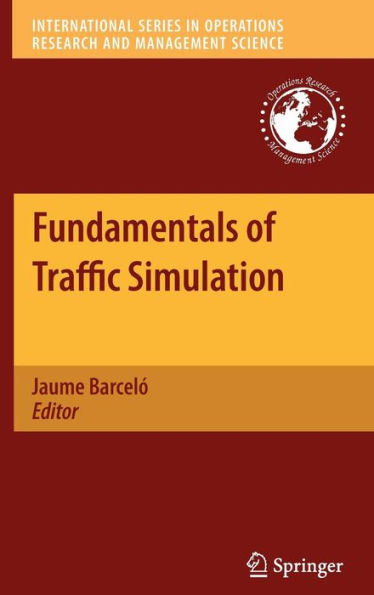Fundamentals of Traffic Simulation
The increasing power of computer technologies, the evolution of software en- neering and the advent of the intelligent transport systems has prompted traf c simulation to become one of the most used approaches for traf c analysis in s- port of the design and evaluation of traf c systems. The ability of traf c simulation to emulate the time variability of traf c phenomena makes it a unique tool for capturing the complexity of traf c systems. In recent years, traf c simulation – and namely microscopic traf c simulation – has moved from the academic to the professional world. A wide variety of traf- c simulation software is currently available on the market and it is utilized by thousands of users, consultants, researchers and public agencies. Microscopic traf c simulation based on the emulation of traf c ows from the dynamics of individual vehicles is becoming one the most attractive approaches. However, traf c simulation still lacks a uni ed treatment. Dozens of papers on theory and applications are published in scienti c journals every year. A search of simulation-related papers and workshops through the proceedings of the last annual TRB meetings would support this assertion, as would a review of the minutes from speci cally dedicated meetings such as the International Symposiums on Traf c Simulation (Yokohama, 2002; Lausanne, 2006; Brisbane, 2008) or the International Workshops on Traf c Modeling and Simulation (Tucson, 2001; Barcelona, 2003; Sedona, 2005; Graz 2008). Yet, the only comprehensive treatment of the subject to be found so far is in the user’s manuals of various software products.
1129749191
Fundamentals of Traffic Simulation
The increasing power of computer technologies, the evolution of software en- neering and the advent of the intelligent transport systems has prompted traf c simulation to become one of the most used approaches for traf c analysis in s- port of the design and evaluation of traf c systems. The ability of traf c simulation to emulate the time variability of traf c phenomena makes it a unique tool for capturing the complexity of traf c systems. In recent years, traf c simulation – and namely microscopic traf c simulation – has moved from the academic to the professional world. A wide variety of traf- c simulation software is currently available on the market and it is utilized by thousands of users, consultants, researchers and public agencies. Microscopic traf c simulation based on the emulation of traf c ows from the dynamics of individual vehicles is becoming one the most attractive approaches. However, traf c simulation still lacks a uni ed treatment. Dozens of papers on theory and applications are published in scienti c journals every year. A search of simulation-related papers and workshops through the proceedings of the last annual TRB meetings would support this assertion, as would a review of the minutes from speci cally dedicated meetings such as the International Symposiums on Traf c Simulation (Yokohama, 2002; Lausanne, 2006; Brisbane, 2008) or the International Workshops on Traf c Modeling and Simulation (Tucson, 2001; Barcelona, 2003; Sedona, 2005; Graz 2008). Yet, the only comprehensive treatment of the subject to be found so far is in the user’s manuals of various software products.
329.0
In Stock
5
1

Fundamentals of Traffic Simulation
442
Fundamentals of Traffic Simulation
442
329.0
In Stock

Product Details
| ISBN-13: | 9781441961419 |
|---|---|
| Publisher: | Springer New York |
| Publication date: | 09/27/2010 |
| Series: | International Series in Operations Research & Management Science , #145 |
| Edition description: | 2010 |
| Pages: | 442 |
| Product dimensions: | 6.30(w) x 9.30(h) x 1.20(d) |
From the B&N Reads Blog
